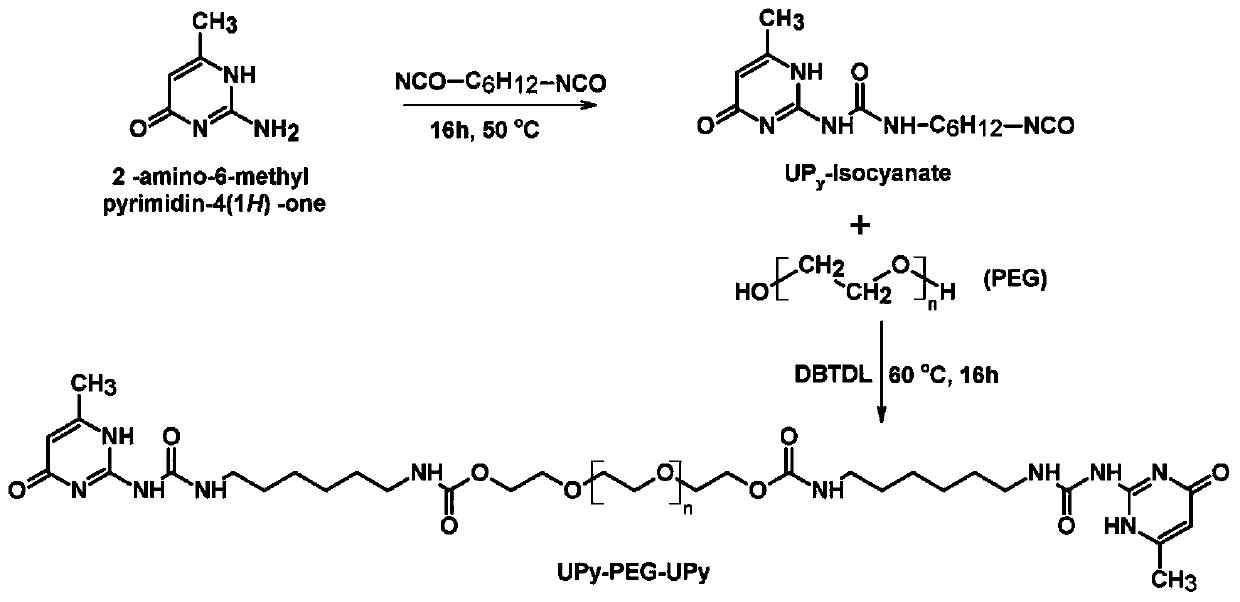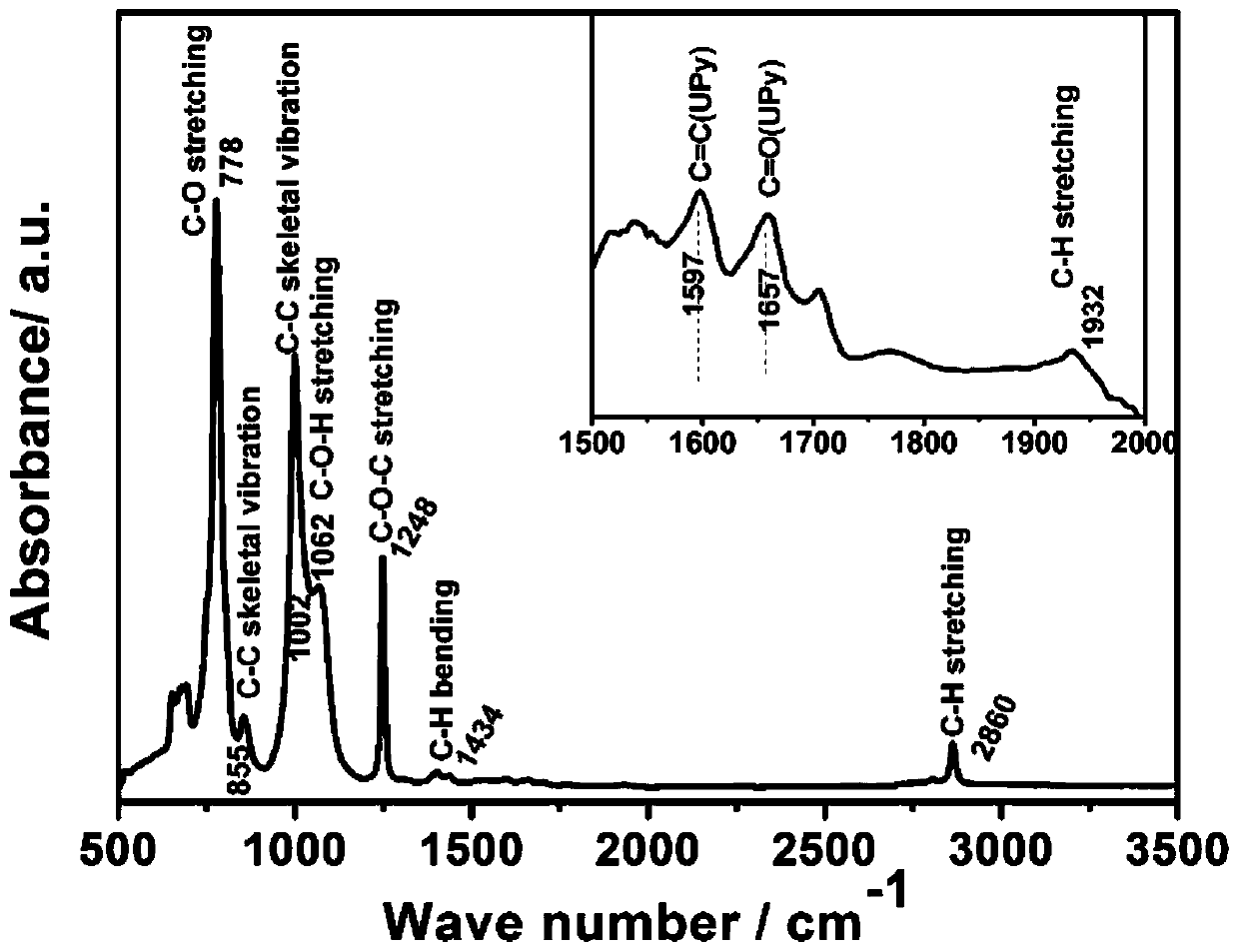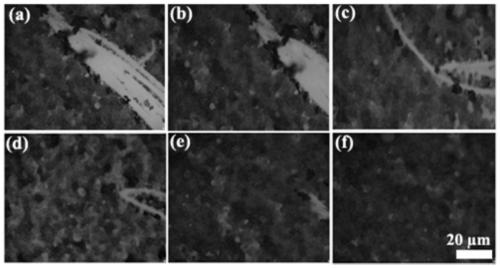Self-repairing adhesive and preparation method and application thereof
An adhesive and self-healing technology, applied in the field of chemical energy storage, can solve the problems of volume expansion of alloy-type electrode materials, and achieve the effects of low cost, good self-healing ability and good cycle stability
- Summary
- Abstract
- Description
- Claims
- Application Information
AI Technical Summary
Problems solved by technology
Method used
Image
Examples
Embodiment 1
[0025] A self-healing adhesive is a UPy-PEG-UPy adhesive, and its specific structural formula is as follows:
[0026]
[0027] In the formula, n is 70.
[0028] A method for preparing a self-healing adhesive, the steps comprising
[0029] Step 1: Mix 2amino-6methyl-4[1H]-pyrimidinone and hexamethylene diisocyanate at a molar ratio of 1:0.8, heat to 45°C, and keep warm for 20 hours to prepare UPy-isocyanate;
[0030] Step 2: Dissolve polyethylene glycol, dibutyltin dilaurate and UPy-isocyanate in chloroform, wherein the molar ratio between polyethylene glycol, dibutyltin dilaurate and UPy-isocyanate is 1:0.01:3, After dissolving, heat it to 55° C., keep it warm for 20 hours, and obtain UPy-PEG-UPy adhesive after refluxing.
Embodiment 2
[0032] A self-healing adhesive is a UPy-PEG-UPy adhesive, and its specific structural formula is as follows:
[0033]
[0034] In the formula, n is 80.
[0035] combine figure 1 Shown, a kind of preparation method of self-healing adhesive, the step comprises
[0036] Step 1: Mix 2amino-6methyl-4[1H]-pyrimidinone and hexamethylene diisocyanate at a molar ratio of 1:1, heat to 50°C, and keep warm for 16 hours to prepare UPy-isocyanate;
[0037] Step 2: Polyethylene glycol, dibutyltin dilaurate and UPy-isocyanate are dissolved in chloroform, wherein the molar ratio between polyethylene glycol, dibutyltin dilaurate and UPy-isocyanate is 1:0.02:4, After dissolving, heat it to 60° C., keep it warm for 16 hours, and obtain the UPy-PEG-UPy adhesive after refluxing.
Embodiment 3
[0039] A self-healing adhesive is a UPy-PEG-UPy adhesive, and its specific structural formula is as follows:
[0040]
[0041] In the formula, n is 100.
[0042] A method for preparing a self-healing adhesive, the steps comprising
[0043] Step 1: Mix 2amino-6methyl-4[1H]-pyrimidinone and hexamethylene diisocyanate at a molar ratio of 1:1.2, heat to 55°C, and keep warm for 10 hours to prepare UPy-isocyanate;
[0044] Step 2: Polyethylene glycol, dibutyltin dilaurate and UPy-isocyanate are dissolved in chloroform, wherein the molar ratio between polyethylene glycol, dibutyltin dilaurate and UPy-isocyanate is 1:0.03:5, After dissolving, heat it to 65° C., keep it warm for 10 hours, and obtain the UPy-PEG-UPy adhesive after refluxing.
[0045] Taking Example 2 as an example, study its structure and performance:
[0046] combine figure 2 Shown, in the infrared absorption spectrum can be seen, 1597 and 1657cm -1 and 1932cm -1 The three infrared absorption peaks at corresp...
PUM
 Login to View More
Login to View More Abstract
Description
Claims
Application Information
 Login to View More
Login to View More - R&D
- Intellectual Property
- Life Sciences
- Materials
- Tech Scout
- Unparalleled Data Quality
- Higher Quality Content
- 60% Fewer Hallucinations
Browse by: Latest US Patents, China's latest patents, Technical Efficacy Thesaurus, Application Domain, Technology Topic, Popular Technical Reports.
© 2025 PatSnap. All rights reserved.Legal|Privacy policy|Modern Slavery Act Transparency Statement|Sitemap|About US| Contact US: help@patsnap.com



